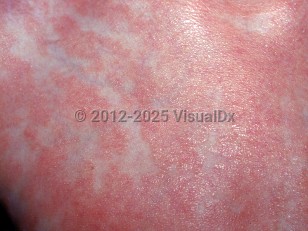Juvenile pityriasis rubra pilaris
Alerts and Notices
Important News & Links
Synopsis

This summary discusses pityriasis rubra pilaris in children. Pityriasis rubra pilaris in adults is addressed separately.
Juvenile pityriasis rubra pilaris (PRP) is an inflammatory disorder affecting cornification with onset in childhood. PRP is usually acquired, but there are heritable forms. It can present in 3 clinical forms: type III (classical), type IV (circumscribed), and type V (atypical). Overlap between these subtypes is common in children.
In classical / type III (10% of all cases), there is a fairly rapid onset of extensive, confluent, scaling, pink-orange plaques in association with keratoderma of the hands and feet. Age of onset may be at any time during childhood, with a peak around age 6. Half of all cases resolve without therapy in less than 6 months, although many take longer to resolve and 10%-20% may become chronic.
Circumscribed / type IV (25% of all cases) primarily involves the extensor knees and elbows with palmoplantar keratoderma. It is the most common pediatric subtype. Onset is most commonly at age 3-9 years. The rate of spontaneous resolution is similar to classical juvenile / type III PRP.
Atypical / type V (less than 5% of all cases) is present from birth or in the first few years of life. It may be inherited in an autosomal dominant pattern due to activating mutations in CARD14.
Juvenile pityriasis rubra pilaris (PRP) is an inflammatory disorder affecting cornification with onset in childhood. PRP is usually acquired, but there are heritable forms. It can present in 3 clinical forms: type III (classical), type IV (circumscribed), and type V (atypical). Overlap between these subtypes is common in children.
In classical / type III (10% of all cases), there is a fairly rapid onset of extensive, confluent, scaling, pink-orange plaques in association with keratoderma of the hands and feet. Age of onset may be at any time during childhood, with a peak around age 6. Half of all cases resolve without therapy in less than 6 months, although many take longer to resolve and 10%-20% may become chronic.
Circumscribed / type IV (25% of all cases) primarily involves the extensor knees and elbows with palmoplantar keratoderma. It is the most common pediatric subtype. Onset is most commonly at age 3-9 years. The rate of spontaneous resolution is similar to classical juvenile / type III PRP.
Atypical / type V (less than 5% of all cases) is present from birth or in the first few years of life. It may be inherited in an autosomal dominant pattern due to activating mutations in CARD14.
Codes
ICD10CM:
L44.0 – Pityriasis rubra pilaris
SNOMEDCT:
238620000 – Classical juvenile pityriasis rubra pilaris
L44.0 – Pityriasis rubra pilaris
SNOMEDCT:
238620000 – Classical juvenile pityriasis rubra pilaris
Look For
Subscription Required
Diagnostic Pearls
Subscription Required
Differential Diagnosis & Pitfalls

To perform a comparison, select diagnoses from the classic differential
Subscription Required
Best Tests
Subscription Required
Management Pearls
Subscription Required
Therapy
Subscription Required
References
Subscription Required
Last Reviewed:05/08/2023
Last Updated:05/22/2023
Last Updated:05/22/2023
Juvenile pityriasis rubra pilaris

